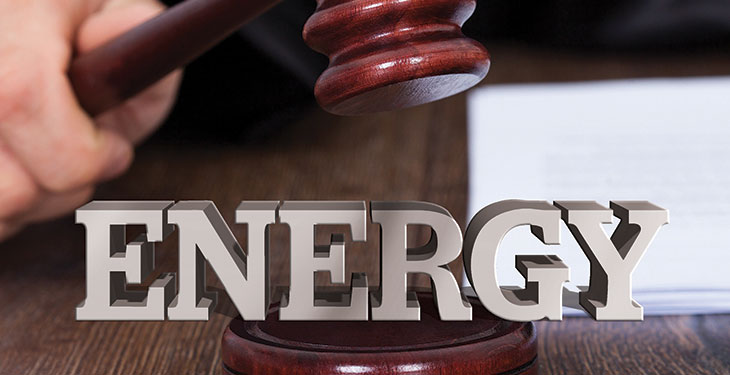Although we have listed here only a small part of the challenges faced by the energy industry, a common denominator remains the energy governance, with all that it entails, namely the stability of laws and regulations, functionality of the public authorities without excessive bureaucracy, transparency of decision-making process and fair consultation between all stakeholders.
 Drafting and amending the legal framework in the energy sector should also be aligned with tax regulations, technical, safety and labour protection regulations in force in Romania and the EU, but also with internationally accepted best practices and standards of operation and financing, in order to enhance the competitiveness of the local industry in a globalized world. Improving the legal framework in a timely manner in the energy sector is one of the most important levers in securing the investors’ confidence, in ensuring security and continuity of supply at affordable prices to households, all of which, ultimately, generates major beneficial effects on the economy as a whole.
Drafting and amending the legal framework in the energy sector should also be aligned with tax regulations, technical, safety and labour protection regulations in force in Romania and the EU, but also with internationally accepted best practices and standards of operation and financing, in order to enhance the competitiveness of the local industry in a globalized world. Improving the legal framework in a timely manner in the energy sector is one of the most important levers in securing the investors’ confidence, in ensuring security and continuity of supply at affordable prices to households, all of which, ultimately, generates major beneficial effects on the economy as a whole.
Land access to the petroleum blocks
As one of the oldest and most profitable industries in the Romanian history, the oil and natural gas industry has suffered, during the recent years, a strong downward trend, caused by both the crisis on the international markets along with the oil prices collapse, but also internally, by some real challenges, especially bureaucratic and legislative. Such that, constantly, the representatives of the petroleum industry have been actively advocating for the amendment of the main special laws applicable in the sector in order to remedy the practical problems lacking clear legal support and for the alignment of the specific regulatory framework with the modern international practices. Many of those legislative gaps negatively affect the day-to-day activity of the operators, which are eagerly expecting effective solutions. In this context, important projects in the exploration field suffered delays and significant additional costs, and consequently, dettering important investments.
 One of the most delicate problems is the land access to the petroleum blocks. The recent Law no. 197/2016 approving the Government Emergency Ordinance no. 22/2014 amending and supplementing the Law no. 50/1991 on authorizing construction works includes, among others, provisions for conducting works of geological survey, exploration or exploitation of oil and natural gas. Therefore, in order to carry out such works, the holders of licenses, authorizations or petroleum agreements are required, inter alia, to prove the creation of a collateral deposit or the payment of the indemnities for the benefit of the owners of the land affected. This is not the case of the construction works related to projects declared as being of national importance in the natural gas sector. In this regard, the former Parliament adopted the Law no. 185/2016 on the projects of national interest in the natural gas sector which expressly provides that the access to the land affected by the construction works for carrying out the projects of national importance is not conditioned by the prior payment of the indemnities. Therefore, Law no. 185/2016 establishes derogatory measures from the general provisions regarding the authorization of construction works under the Law no. 197/2016. Considering the differences between the two normative acts, the unification of the legislative solutions for access and use of lands required for petroleum operations is imperative for solving both practical problems and legal controversies.
One of the most delicate problems is the land access to the petroleum blocks. The recent Law no. 197/2016 approving the Government Emergency Ordinance no. 22/2014 amending and supplementing the Law no. 50/1991 on authorizing construction works includes, among others, provisions for conducting works of geological survey, exploration or exploitation of oil and natural gas. Therefore, in order to carry out such works, the holders of licenses, authorizations or petroleum agreements are required, inter alia, to prove the creation of a collateral deposit or the payment of the indemnities for the benefit of the owners of the land affected. This is not the case of the construction works related to projects declared as being of national importance in the natural gas sector. In this regard, the former Parliament adopted the Law no. 185/2016 on the projects of national interest in the natural gas sector which expressly provides that the access to the land affected by the construction works for carrying out the projects of national importance is not conditioned by the prior payment of the indemnities. Therefore, Law no. 185/2016 establishes derogatory measures from the general provisions regarding the authorization of construction works under the Law no. 197/2016. Considering the differences between the two normative acts, the unification of the legislative solutions for access and use of lands required for petroleum operations is imperative for solving both practical problems and legal controversies.
From another perspective, Law no. 185/2016 is already included in the Government’s legislative plans. The functions granted to the Ministry of Energy related to the authorizing construction works for this kind of projects will be restored to the mayors and presidents of the County Councils through an Emergency Ordinance (InvesTenergy.ro).
Transgaz has started working on the romanian sector of BRUA
In respect to the status of the regional interconnectivity on the gas market, Romania has made good progress in 2016 along with the completion of works to the pipeline Giurgiu-Ruse, part of the interconnector Bulgaria – Romania – Hungary – Austria. The pipeline ensures the bidirectional flow of natural gas between Bulgaria and Romania. The tenders for capacity booking on the pipeline Giurgiu-Ruse started this year on the Regional Booking Platform operated by FGS. A 150.000kWh/day/month export capacity was booked for Bulgaria-Romania from the total of 21.6 million kWh/day/month capacity auctioned. Instead, no capacity booking was made for Romania-Bulgaria, although it was auctioned a total capacity of 1.62 million kWh/day/month, which means that Romania is not yet interested to export gas to the southern neighbors where the gas price is lower.
The pipeline Iasi-Ungheni (Romania-Moldova) is functional, but the amount of natural gas exported was below expectations (1 mil. cubic meters). The pipeline Szeged-Arad is used for the natural gas import from Hungary while the physical gas exports are not possible because of the difference of pressure between the transmission operators from both countries, aspect which requires additional investments from Romania’s part, leaving aside the occasional small virtual exports type “backhaul”.
Acting in accordance with one of the pillars of the EU Energy Security Strategy, Romania has assigned to the national transmission system operator, Transgaz, the responsibility to carry out a key project, the construction of a 550 km natural gas pipeline on the Romanian territory, part of the European project BRUA, ensuring the interconnection of the transmission systems from Romania, Bulgaria, Hungary and Austria.
The Regulatory authorities from Bulgaria, Greece, Hungary, Poland and Romania signed in February 2017 a general unilateral declaration on the applicability of all Third Energy Package gas network codes on interconnection points (IP) between Energy Community Contracting Parties (cooperation between EU countries and non-EU countries, countries from the South-Eastern Europe, in order to ensure an electricity and gas market) and EU Member States (energetika.net), as a first step in the process of the preparation of the network codes. Energy Community’s approach was aimed for that “the EU and Energy Community markets to operate as one regulatory space for the benefit of the system security, security of supply, market functioning and above all, the energy consumers”, as the energetika.net online platform put it.
No restrictons for export
Romania’s capacity to be a regional player and more specifically, an exporter, becomes more relevant in the context of the recent evolution of the domestic natural gas market, characterized as an oligopoly market with two large producers and a few small ones, isolated and with a single import source. In 2016, the price of natural gas from domestic production exceeded the price of imported gas, causing an increase with over 600% of the level of imported gas in the first 11 months of 2016 compared to the same period of 2015. The big participants to the natural gas market decided to import gas considering the fact that the price of the natural gas traded on the international markets was lower with even RON 20/MWh than the price of the locally produced and stored gas. Along with the amendment of the Electricity and Natural Gas Law no. 123/2012 through the Government Emergency Ordinance no. 64/2016, the legal restrictions regarding the natural gas exports were removed starting with 1st April 2017. The former regulation provided an indirect restriction to exports applicable to the natural gas producers by imposing the obligation to supply with priority the amount of gas necessary for the natural gas consumption for households and heat producers. The amendment of the law came in as a consideration of the fact that the European Commission launched in 2012 an infringement procedure against Romania for imposing de facto restriction to export through the Law no. 123/2012. Following this legislative change, an increase of the natural gas transactions on the Romanian market is expected from 1st April 2017, unless a further revision of the law is adopted through an emergency procedure.
Also, the number of natural gas transactions on the stock market is increasing, trend which will also continue in 2017 given the fact that the natural gas producers and suppliers have the obligation to trade on competitive markets a certain percentage of the amount of natural gas for which they have the obligation to conclude agreements as producers – sellers or, if suppliers, as sellers or buyers. In 2016, on the RCE (Romanian Commodities Exchange) a volume of at least 4.15 TWh was traded and the transactions seem to continue on an ascending trend also in 2017.
Interconnection and being part of a liquid market
Although the oil depletion as a primary energy source seems to be far, it is clear that the sector is going through one of the most prominent periods of transformation in its history, which will ultimately redefine the energy business as we know it. The oil crisis had a deep negative impact, with substantial projects being cancelled, upstream companies making share capital decreases of 30-40% in the last 2 years and the horizontal effects have led to bankruptcy and to the retreat from the market of major suppliers of equipment and services.
The challenge of global decarbonisation and the significant increase of renewable resources within the energy mix at the European level trigger questions with respect to the right balance between adoption and alignment with international trends and treaties, versus preserving a local optimum energy mix. The “inherited” energy mix still depends on fossil fuels and on the ability to attract investments to modernize and improve the energy production processes, from upstream to the end consumer. For these questions appropriate answers should be found in our country’s energy strategy, whereas the interconnection and the affiliation to a liquid and competitive market represent a pressing problem. This year, expectations are focused on clarifying the taxation system applicable to the petroleum concessions,. Whilst multiple approaches were mentioned in recent years for this matter, including an introduction of a special hydrocarbon tax, once clarified, would open the opportunity for investment and tenders for new petroleum concessions, provided that the new tax regime would be supportive enough to attract new players. It is also envisaged a review of the Petroleum Law, in order to clarify several issues concerning the access to lands, the concessions’ approval methods, the regime of petroleum operations and data belonging to the National Geological Fund. The public consultations’ stage is awaited with much interest by all stakeholders active in the field, interest derived from the strong need for a stable, predictable and investment-oriented legal framework.
More transparency for the electricity market
As far as concerns the electricity market, important changes have been announced by ANRE last month, changes regarding the electricity import/export contracts. The parties of such contracts are required to submit with the electricity market operator a copy of these contracts, within seven days from the signing date. The provision is supplemented by the electricity operator’s obligation to not disclose information with respect to the electricity transactions, owned and obtained during its activity, otherwise than under the law. From the point of view of ensuring a competitive and transparent investment environment, the measure is appropriate, but this should not conflict with clauses inserted in such contracts as confidential.
Important changes are also expected in the renewable energy sector, given that the Ministry of Energy published on 16.02.2017 a draft Government Emergency Ordinance amending Law no. 220/2008 on establishing the system for promoting energy from renewable sources. The Draft GEO was launched for public debate following the approval of the amendments to the green certificate support mechanism by the European Commission. The establishment of a market for anonymously trading green certificates, different from the electricity trading markets and, as well as, the taxation of green certificates only when traded, are measures that have potential to improve the crisis in this area. These measures could improve the investment climate, given that the renewables market has stagnated in recent years due to unfavorable legislative changes for producers.
In order to ensure a competitive environment, given the significant increase of the energy price on the stock market within the last two months and the unilateral termination of contracts by certain suppliers, ANRE initiated the process to establish the Investigations Department for assessing whether or not the price on the energy market was manipulated. In January 2017, the energy price on OPCOM (Romanian Electricity and Gas Market Operator) recorded the highest rate in Europe, reaching 96,52 euros per MWh, according to data released by the operator. However, it cannot be excluded the fact that a contribution to such situations with major impact on the market (including insolvency of certain suppliers) is not due to different regulations in the wholesale energy market, very rigid, and the retail energy market, very flexible. These regulatory differences are constantly challenged of by industry associations (AFEER), which are actively advocating for the market flexibility and for the enhancement of trading discipline.
Mining – vulnerability and solution
In the mining sector, according to the 2016-2030 Romanian Energy Strategy, with an Outlook to 2050, several vulnerabilities that relate to the inefficient exploitation of various raw materials are notable.
One of the vulnerabilities represents the problem of the power plants based on lignite and coal. A favourable climate for the low greenhouse gas technologies due to a possible increase in the price of carbon certificates may influence the coal production, trend stated within the Strategy. In Romania, the medium-rank and low-rank coal production depends directly on the national demand of raw material for electricity generation, but also on the evolution of the prices of the raw materials, on the efficiency and flexibility in operation of the power plants.
The State-controlled “flagship” companies are facing a difficult economic and social situation and this issue should be addressed as a priority, given that 25.4% of the energy production reported in early 2017 was covered by the coal plants (source: Transgaz). It is estimated that the energy mix of U.E. will still be heavily based on fossil fuels, including coal (source: Center for Industrial Economics and Services, National Institute of Economic Research) and for the countries from Central and Eastern Europe, coal will be the main pillar in the energy security even in 2035. According to the 2012-2035 Mining Industry Strategy, one of the main Romanian strengths is the existence of exploitable coal reserves – over 300 million tons, concentrated in a single deposit, with a lifespan of exploitation of about 100 years, and for the lignite – over 500 million tons.
—————————————-
The full version of this article can be read in printed edition of energynomics.ro Magazine, issued in March 2017.
In order to receive the next issue (June 2017) of energynomics.ro Magazine, we encourage you to write us at office [at] energynomics.ro to include you in our distribution list.
